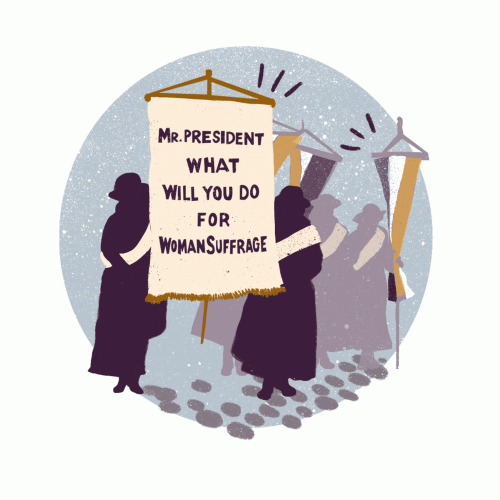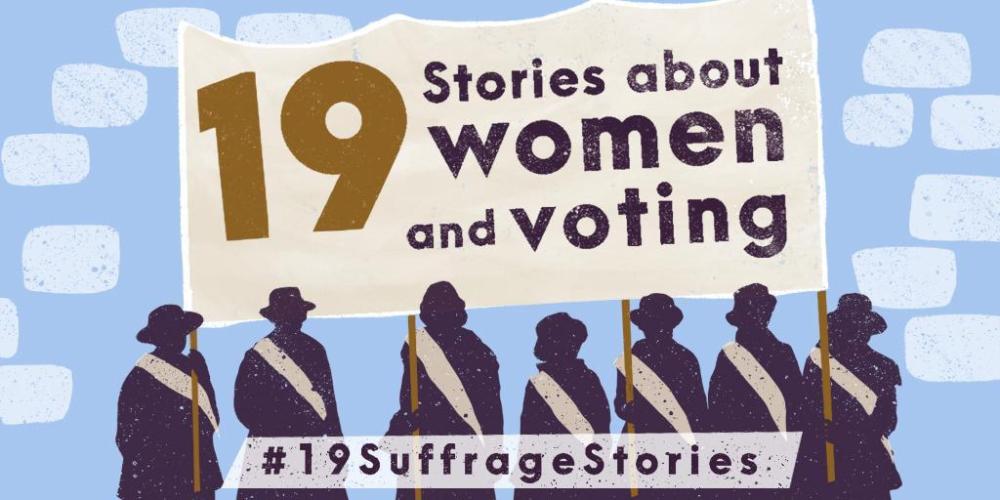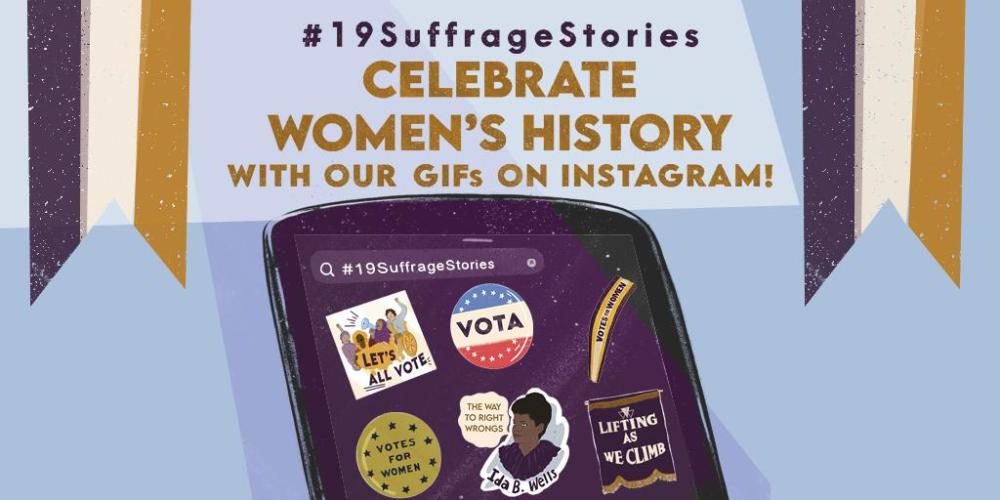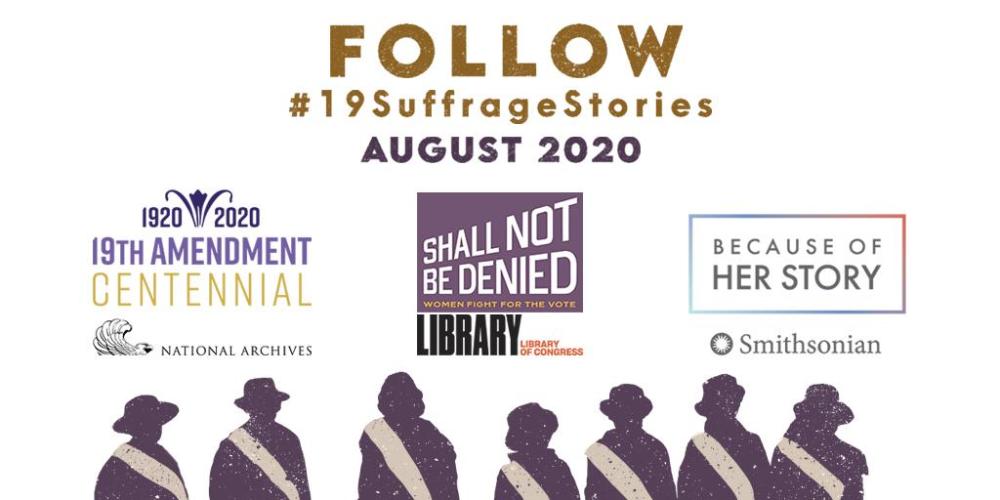
Women fought long and hard for the vote—before and after the passage of the 19th Amendment, which declares the right to vote "shall not be denied...on account of sex." Diverse communities and organizations blazed the trail for equal voting rights across the nation. For many women, especially women of color, the fight didn't end when the 19th Amendment went into effect on August 26, 1920. Yet the stories of these suffragists have often been overlooked.
To mark the centennial of the 19th Amendment, the Smithsonian, Library of Congress, and National Archives are collaborating to bring these stories to you on social media. From today until August 26, you can follow weekday posts to learn voting-rights history drawn from all three institutions' collections. You can also use our set of animated social media GIFs and Instagram stickers on your social media posts to mark the centennial.

Follow these accounts on social media to experience #19SuffrageStories:
- Smithsonian on @Smithsonian Instagram and Twitter
- National Archives @USNatArchives on Instagram and Twitter
- Library of Congress @LibraryCongress on Instagram and Twitter
Don't just learn this history—make it your own and share it with friends. Add our 10 new voting-inspired stickers, designed by Krystal Quiles in partnership with Smithsonian Digital Studio, to your Instagram stories. Don a historic suffrage sash in your selfie. Add the words of suffragists Ida B. Wells, Marie Louise Bottineau Baldwin, and Dr. Mabel Ping-Hua Lee to your posts. To use the stickers, create an Instagram Story, click on the sticker icon, and search for #19SuffrageStories. You can also find GIFs of all the stickers through GIPHY.

Explore the stories behind the stickers and share them on social media:

This sticker is an illustrated version of the iconic women's suffrage sash. Suffragists wore these to rallies, parades, and public-speaking opportunities to get out their message. You can use this sticker to virtually wear a sash and show your support for the women who worked to win voting rights.

Cofounded by Mary Church Terrell, the National Association of Colored Women's motto can be seen on this banner in the collection of our National Museum of African American History and Culture. The organization promoted suffrage, education, and other causes. "Lifting as we climb" represented a call for African American women to work for the "uplift" and empowerment of others in the African American community through suffrage, education, and community service. Learn more about the origins of the National Association of Colored Women.

A modern interpretation of signs used by groups to promote civic engagement, this sticker was inspired by a 1956 photograph in the collection of the National Museum of African American History and Culture. The African American women in this photograph were lined up along the Citizenship Education Project's motorcade route encouraging voting and voter registration. Many African American women could not vote unimpeded until 1965 with the passage of the Voting Rights Act—long after the 19th Amendment went into effect.

More than 1,000 women joined picket lines outside the White House during 1917 to demand voting rights for women, as shown in this photograph from the Library of Congress. They wanted President Woodrow Wilson's support of an amendment to the Constitution to grant women the vote. Their signs read, "Mr. President, what will you do for Woman Suffrage?" and "How Long Must Women Wait for Liberty?" Though President Wilson often tipped his hat as he rode through the White House gates, police arrested the protestors. Between June and November, 218 protesters from 26 states were arrested and charged with "obstructing sidewalk traffic."

A portrait of Ida B. Wells in the Smithsonian's National Portrait Gallery inspired this sticker. Wells cofounded the Alpha Suffrage Club in Chicago in 1913 to advocate for women's rights and to push for the election of African Americans. She also famously refused to march in a segregated section of a suffrage parade that same year in Washington, D.C. As an investigative journalist, she fought for civil rights, traveling the South and gathering records in a decades-long campaign against lynching that made its horrors known nationwide. Her quote, "The way to right wrongs is to turn the light of truth upon them," comes from her book, The Light of Truth: Writings of an Anti-Lynching Crusader.

Marie Louise Bottineau Baldwin (Turtle Mountain Band of Chippewa) championed American Indian rights. She often invoked American Indian women's power within their communities in interviews with the press. In 1913, she marched with fellow lawyers in the Washington, D.C., suffrage parade. She was also a leader in the Society for American Indians, an organization that advocated for an act to make American Indian U.S. citizens. The Indian Citizenship Act, passed in 1924, helped some American Indian women gain voting rights, years after the passage of the 19th Amendment. When asked if she was a suffragist in 1914, Baldwin laughed. She asked the reporter, "Did you ever know that the Indian women were among the first suffragists, and that they exercised the right of recall?" This portrait is based on Baldwin's photograph from her personnel file from when she worked for the Federal government. She chose to be photographed in traditional dress, a radical choice for the time. You can learn about Baldwin from the National Archives.

In the early 1900s, Chinese immigrants could not become naturalized citizens, but Mabel Ping-Hua Lee still advocated for voting rights for American women. Lee began writing and speaking publicly about women's suffrage when she was a teenager. At age 16, she rode at the head of a 1912 New York suffrage parade. She later led a contingent of Chinese and Chinese American women in a New York City suffrage parade in 1917. Many women of Asian descent were prevented from becoming citizens and voting until the Chinese Exclusion Act was repealed (1943) and the Immigration and Nationality Act was passed (1952). Her quote in this sticker comes from a speech she gave around 1915 arguing for gender equality in China. You can learn more about Lee from the National Archives.

When you add this "Votes for Women" pin to your selfie, you're "wearing" a historic suffrage symbol from the Smithsonian's National Museum of American History. "It's easy to dismiss buttons, stickers, t-shirts, and giveaways as things that are silly," said National Museum of American History curator Lisa Kathleen Graddy, "But they help us find people who think like we do." See other examples of popular suffrage merch in this video.

Latina suffragists, including Adelina "Nina" Otero-Warren and Maria de Guadalupe Evangelina Lopez de Lowther, ran bilingual campaigns for the vote. Otero-Warren ensured materials were printed in both English and Spanish for the New Mexico chapter of the Congressional Union (later the National Woman's Party). Lopez, head of her local College Equal Suffrage League, gave lectures in Spanish to ensure that the messages of the suffrage movement reached the Latino community in Los Angeles. Copies of Spanish-language suffrage materials are rare. We honor their contributions to the suffrage movement by re-creating pins encouraging Spanish-speakers to vote.

Use this sticker to tell friends and family to follow along! If you follow all 19 stories, you will learn why gold, white, and purple were chosen to represent suffrage.
Make these suffrage stories accessible to all:
In addition, all month long you can join our 19th Amendment Wikipedia Edit-a-thon. Make 19 edits to Wikipedia pages throughout the month of August to help expand the coverage of the women's suffrage movement online. Virtual trainings will be held every Tuesday and Thursday in August from 11:30 a.m.–1 p.m. ET.
